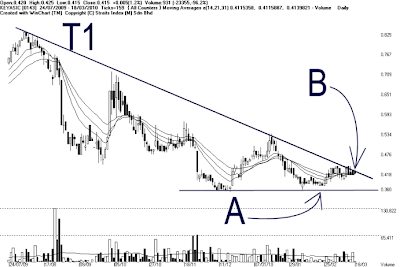TA: Technical Rebound.
Chart 1: TA, from 2/10/2009 to 25/03/2010.
As indicated by chart 1, price of TA rebound from the RM0.66 support, after consolidating above the RM0.66 level for more than a month. As indicated by A, price of TA rebounded again and this time, with volume increasing, as indicated by B. First target of the rebound is at RM0.70, and the increased of volume suggests some increased of inflow of fresh capital to off set some selling pressure.
If price should also break above the RM0.70 level, with volume remains strong, the 14, 21, 31 EMA would, by then, by serving as the dynamic support, as well as the trailing stop reference, and the next resistance is at RM0.78 level. Technically, provided that price is still supported by the 14, 21, 31 EMA, the uptrend remains intact, and it would be a good idea to hold on to the stocks until price should break below the 14, 21, 31 EMA.
On the other hand, if price should failed to break above the RM0.70 level, and started retreat again, and once it should break below RM0.66, it would be making a new low, suggesting that it could be forming a downtrend again, thus a signal to cut loss.
| 4 Q Rolling PER | 12.62 times | Dividend Yield | 0% |
| Dividend | Dividend Yield | Net Profit Ratio | |
| 31/01/2010 | 0 sen | 0% | 20.89% |
| 31/01/2009 | 4.50 sen | 7.32% | 16.94% |
| 31/01/2008 | 10 sen | 7.94% | 41.33% |
| 31/01/2007 | 7 sen | 7.95% | 36.94% |
| 31/01/2006 | 3 sen | 6.34% | 25.54% |
Table 1: TA, yearly dividend, dividend yield, and net profit ratio.
Muhibah: Technical rebound.

Chart 2: Muhibah, from 23/11/2009 to 24/03/2010.
As shown on chart 2, price of Muhibah rebounded from the RM0.91 support after consolidating above the RM0.91 level for quite some time. As indicated by A, price of Muhibah is testing the 14, 21, 31 EMA again.
With volume gradually increasing, it suggests that the buying interest is getting stronger, despite the rebound is not obvious yet. Therefore, if price should start rally, we shall monitor if it should form a higher-low, which is the characteristic of an ideal uptrend. Generally, if price should break above the 14, 21, 31 EMA, the 14, 21, 31 EMA would be serving as the dynamic support as well as the trailing stop reference. Then, the next resistance are found at RM1.09 followed by the RM1.20 WinChart Automatic Fibonacci Retracement.
In contrary, if price should failed to break above the 14, 21, 31 EMA, but instead, breaking below the RM0.91 level, it would be making a new low, thus suggesting the downtrend would resume, and it would be a signal to cut loss for the next support are found at RM0.77 followed by RM0.645.
| 4 Q Rolling PER | 25.68 times | Dividend Yield | 2.66% |
| Dividend | Dividend Yield | Net Profit Ratio | |
| 31/12/2009 | 2.5 sen | 2.72% | 0.64% |
| 31/12/2008 | 2.5 sen | 2.53% | 1.02% |
| 31/12/2007 | 4.5 sen | 1.20% | 4.94% |
| 31/12/2006 | 7.5 sen | 2.88% | 3.06% |
| 31/12/2005 | 4 sen | 5.76% | 2.68% |
Table 2: Muhibah yearly dividend, dividend yield, and net profit ratio.
Uemland UEM: Positive biased movement.
Chart 3: Uemland, from 23/11/2009 to 24/03/2010.
As shown on chart 3, price of UEMland formed a Symmetrical Triangle with L1 being the dynamic resistance line and the L2 being the dynamic support line. As price consolidates within the Symmetrical Triangle, the fluctuation of price is gradually reducing, which is the characteristic of a Triangle. Meanwhile, other than showing a consolidation signal, the Triangle also imply a break out timing, it is when price is near the tip of the Triangle.
As indicated by A, price of UEMLand is now testing the L1 dynamic resistance line, and if price should break above this line, with substantial volume, it would be a bullish break, then the 14, 21, 31 EMA shall serve as the dynamic support as well as the Trailing Stop reference.
On the other hand, if price should retreated after testing the L1 line, and later breaking below the L2 line, it would be a bearish break out, thus a signal suggesting to cut loss. Other than the L1 and L2 line, support for UEMLand is at RM1.38 while the resistance is at RM 1.50.
| 4 Q Rolling PER | 31.14 times | Dividend Yield | 0% |
| Dividend | Dividend Yield | Net Profit Ratio | |
| 31/12/2009 | 0 sen | 0% | 28.44% |
| 31/12/2008 | 0 sen | 0% | 14.50% |
Table 3: Uemland, yearly dividend, dividend yield, and net profit ratio.
Conclusion:
Technically, all uptrend started with a technical rebound, but a wise trader should know that a technical rebound is only a very beginning, thus an uptrend is not yet forming. Therefore, after a rebound, the next feature we should look for is the forming of a higher-low, and confirm with volume, and most of all, with a sound trading plan. This is what makes a professional trader difference from an average trader.
Copyright © 2009 Straits Index (M) Sdn BhdImportant Disclaimer:These content provided by Straits Index (M) Sdn Bhd is solely for education and information purposes only, and do not suggest any investment advices. All information displayed are believed to be accurate and reliable. Interpretation of the data or analysis is at the reader's own risk. Straits Index (M) Sdn Bhd reserves the rights but obligations to update, admen, or even terminate the materials. 重要声明:以上的内容由海峡指数(马)私人有限公司提供,纯粹是教育性质, 并不是任何的投资忠告。所有资料显示认为是准确和可靠的。对数据或分析的解释和用途是在于用户自己的风险。海峡指数(马)有限公司持有保留及义务更新,甚 至终止材料的权利。

























